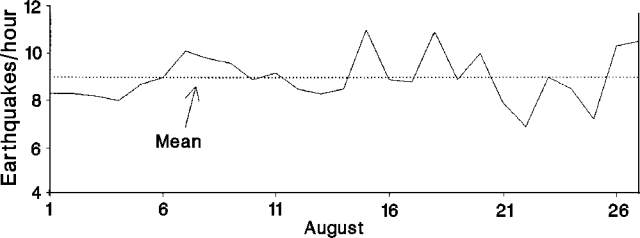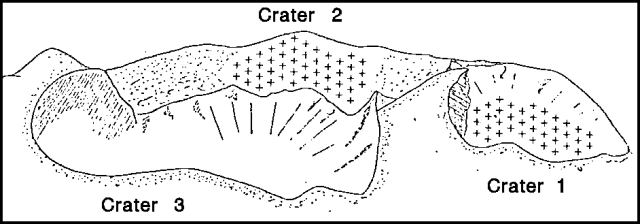Report on Stromboli (Italy) — September 1990
Bulletin of the Global Volcanism Network, vol. 15, no. 9 (September 1990)
Managing Editor: Lindsay McClelland.
Stromboli (Italy) Continued Strombolian activity; new vents
Please cite this report as:
Global Volcanism Program, 1990. Report on Stromboli (Italy) (McClelland, L., ed.). Bulletin of the Global Volcanism Network, 15:9. Smithsonian Institution. https://doi.org/10.5479/si.GVP.BGVN199009-211040
Stromboli
Italy
38.789°N, 15.213°E; summit elev. 924 m
All times are local (unless otherwise noted)
The number of explosions and seismometer-saturating events fluctuated during August, and were apparently inversely correlated (figure 7). The highest peak in saturating events, 86, occurred on 13 August. Average tremor amplitude increased during August, to 12% higher than in July.
 |
Figure 7. Average number of seismic events/hour recorded at Stromboli, August 1990. The mean value for the period is shown. Courtesy of Marcello Riuscetti. |
Explosive activity persisted in Crater 3, throwing cinders and ash to >100 m. Crater 2 resumed visible explosive activity with continuous rumbling 5-10 August, while Crater 1 showed fumarolic activity 6-13 August and explosive activity following the 13th. New vents opened in Crater 2's NW wall on 25 August, and subsequently in Craters 1 and 3 (figure 8). Lapilli and cinders continued to fill the craters, completely covering the two cones in Crater 1 (15:08).
 |
Figure 8. Sketch from "Pizzo sopra la Fossa" looking NW at the summit of Stromboli, August 1990. Courtesy of Marcello Riuscetti. |
Geological Summary. Spectacular incandescent nighttime explosions at Stromboli have long attracted visitors to the "Lighthouse of the Mediterranean" in the NE Aeolian Islands. This volcano has lent its name to the frequent mild explosive activity that has characterized its eruptions throughout much of historical time. The small island is the emergent summit of a volcano that grew in two main eruptive cycles, the last of which formed the western portion of the island. The Neostromboli eruptive period took place between about 13,000 and 5,000 years ago. The active summit vents are located at the head of the Sciara del Fuoco, a prominent scarp that formed about 5,000 years ago due to a series of slope failures which extends to below sea level. The modern volcano has been constructed within this scarp, which funnels pyroclastic ejecta and lava flows to the NW. Essentially continuous mild Strombolian explosions, sometimes accompanied by lava flows, have been recorded for more than a millennium.
Information Contacts: M. Riuscetti, Univ di Udine.

